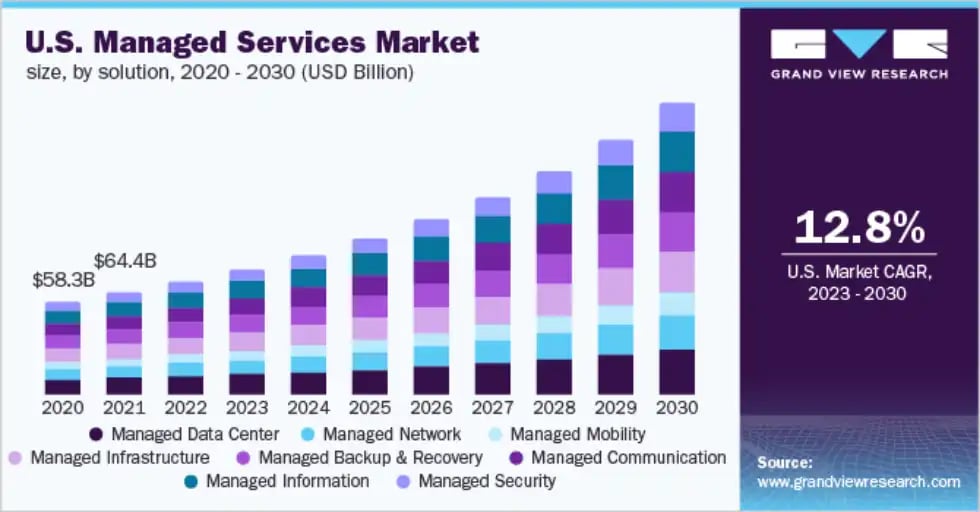The Complete Managed IT Pricing Guide for Small Businesses
To say that managed IT services are an attractive option for small and medium-sized businesses would be no understatement.
In 2022, the global managed service market was worth $267.3 billion in 2022. It is expected to grow by a compound annual growth rate (CAGR) of 12.8% between 2023 and 2030.
While this is certainly good news, every small business looking for expert IT management faces an important crossroads when it comes to these services: managed IT pricing and its budgetary impact.
There are many variables that can impact managed IT service rates, which can make it difficult to accurately estimate your total managed IT costs without using a managed IT services ROI calculator.
Unfortunately, in most cases, it’s not always possible to find a functional calculator. However, despite that, it’s still possible to make sense of managed IT services pricing.
If you are a business owner and are wondering “How much does managed IT services cost?” we’ve got you covered. This article will take a closer look at managed IT pricing, the different pricing models that exist, and how to estimate the costs for your managed services agreement.
Need More Information About Our Managed IT Services Rates?
Get all the details on our managed IT pricing to ease your decision-making process.
Learn MoreAn Overview of Common Managed IT Pricing and Service Models
When it comes to managed IT services pricing, there are two methods providers use for billing their services:
1. Break-Fix
Often referred to as a “pay-as-you-go” plan, break-fix provides reactive or project-based IT support services, usually at an hourly rate. This managed IT pricing model can be subject to additional costs for unsupported services, such as continuous monitoring or troubleshooting.
2. Subscription-Based (Managed Services)
Managed services proactively manage your infrastructure, technology, and processes, offering various services, support, and solutions that cover your evolving IT needs. With a predictable monthly fee, businesses of all sizes can easily scale and tailor their managed services to accommodate their rapidly changing IT requirements.
Now that you understand the methods that managed services providers use for pricing, let’s explore 7 common service models.
3. Per-Device Pricing
This managed IT services pricing model charges a flat fee for each device under management. For example, a provider may charge a monthly fee for each server, desktop, or network device they manage.
4. Per-User Pricing
This model charges a flat fee for each individual user on your network. It can be beneficial for businesses with a high number of devices per user, as the cost remains consistent regardless of the number of devices used.
5. Tiered Pricing
Tiered pricing offers different levels of service, sometimes referred to as “bronze,” “silver,” and “gold” plans. Each tier includes a specific set of services, with the higher tiers offering more comprehensive support and proactive management.
6. All-Inclusive Pricing
This model, also known as “flat-rate” or “fixed-fee” pricing, charges a single monthly fee for all of your managed IT services. This option provides predictable costs and can include a wide range of services, from routine maintenance to emergency support.
7. A La Carte Pricing
This model is among the most flexible, as it gives clients the power to create a customized package featuring only the services their business requires.
8. All-You-Can-Eat Pricing
Designed for larger enterprises that are not bound by budgetary limitations, this all-inclusive option provides complete coverage and unlimited on-site and remote support.
9. Monitoring Only
As its name suggests, this model provides clients with access to services that include help desk services, ongoing network monitoring, and security alerting services.

Source: Grand View Research
Factors That Influence Managed IT Services Pricing
Now that you have some insight into managed IT pricing models, let’s examine some of the factors that can influence the cost of managed IT services. These include:
1. Service Level Agreements (SLAs)
The level of service and response times outlined in the SLA can impact your pricing. Faster response times and higher service levels often come at a premium.
2. Geographic Location
The cost of living and labor rates in your area can affect the overall cost of fully managed IT services. Providers in higher-cost regions may charge more for their services.
3. Company Size and IT Complexity
The size of your business and the complexity of your IT infrastructure can affect your managed IT services rates. Larger companies with more extensive infrastructure will typically require more support, driving up costs.
4. Customization and Special Requests
Customizing your managed IT services plan to meet your specific needs may result in additional costs. Special requests or add-ons not included in a standard package will often come at an additional fee.
5. Evolving Technology Needs
Managed services provide easy scalability for evolving technology needs, offering a significant advantage to small and medium-sized businesses as they grow and adapt.
6. Service and Resolution Time
An IT provider that dedicates more time to resolving IT problems or addressing infrastructure issues can impact your managed IT pricing unless otherwise specified in their SLAs.
How Much Does Managed IT Services Cost? (Narrowing to an Indirect Estimate)
While it’s somewhat difficult to provide an exact cost for managed IT services, it’s possible to offer a rough estimate for the price range based on industry averages.
Small to mid-sized businesses can expect to pay anywhere between $125 and $175 per user per month, and between $35 and $250 per device per month.This depends on the pricing model and service level.
Keep in mind that these estimates can vary greatly depending on your specific requirements, geographic location, and the factors discussed in the previous section.
How to Estimate Your Costs Without a Managed IT Services Calculator
To estimate your managed IT costs without using a managed IT services ROI calculator, follow these steps:
- Identify the pricing model that best aligns with your needs. Consider the number of devices or users in your organization and determine which pricing model would be most cost-effective.
- Research industry averages. Investigate the average costs for managed IT services in your area to get a sense of what you can expect to pay, and compare it to the managed IT services price list from providers you want to partner with.
- Consider your organization’s needs and IT complexity. Assess the complexity of your IT infrastructure and the level of support you require. This will help you determine the exact services your business needs while avoiding those that you do not.
Interested in learning more about managed IT services? Check our these blogs: |
Learn More About Managed IT Services Pricing From a Trusted Partner
Understanding the different types of managed IT pricing can be difficult, but it doesn’t have to be. With help from a trustworthy managed service provider, you can find what you need for your business while reducing your managed IT costs.
For more than 25 years, Gravity Systems has provided dependable managed IT services for business in Austin, Texas and beyond. We offer a complete range of services that cover your needs, and convenient month-to-month contracts.
If you’re interested in a managed IT partnership that can propel your business forward, contact us today to schedule a free consultation.




